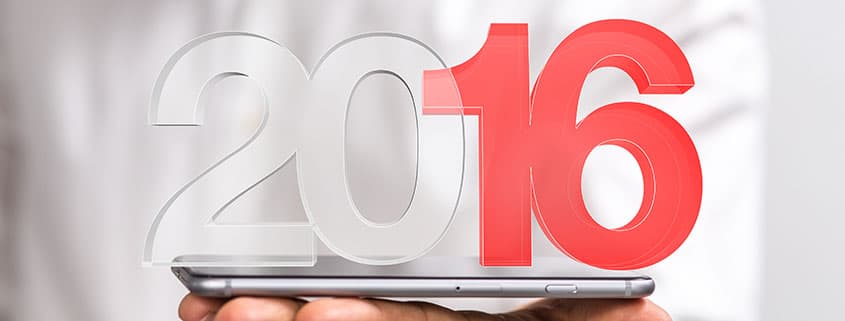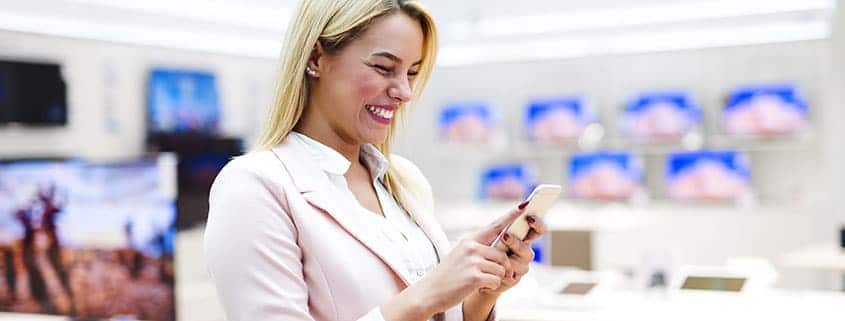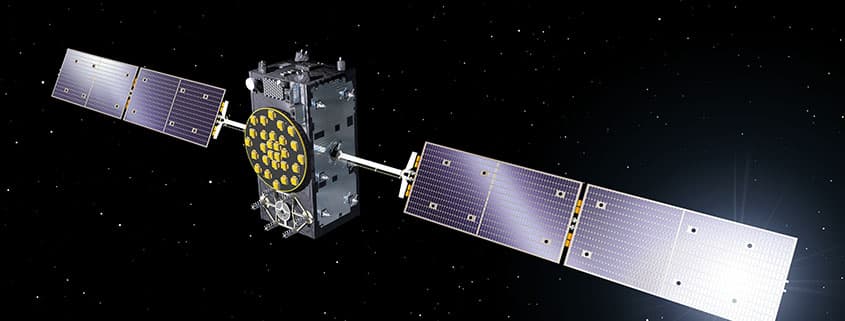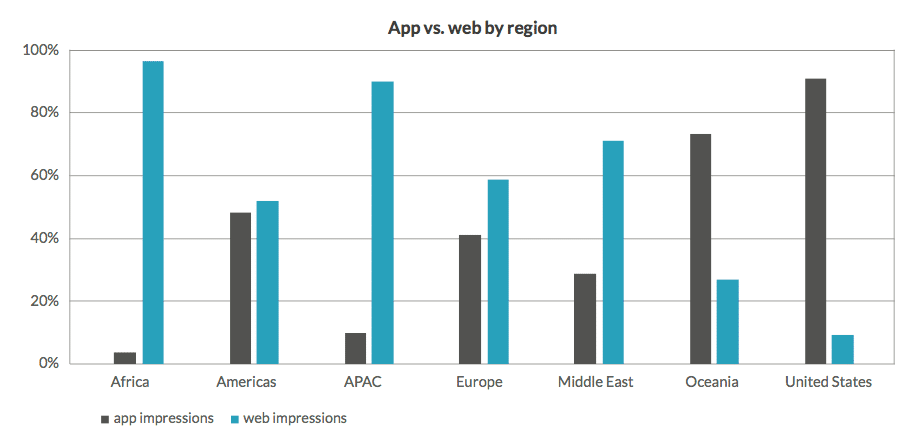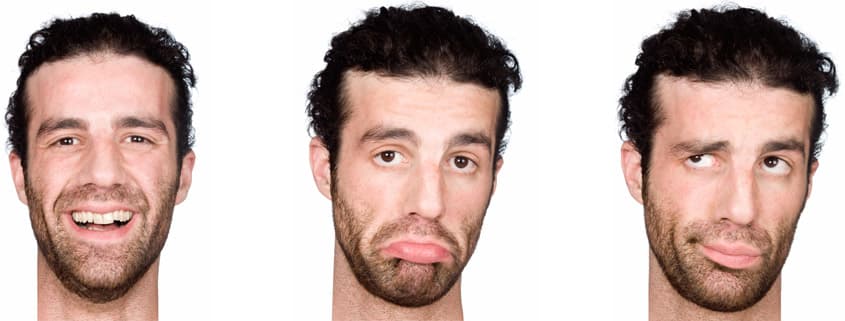It is inevitable: At this time of the year, we must publish our wild speculations thoroughly researched predictions for the upcoming year. Some are obvious, like counting 1 + 1, the others (those at the bottom) are just wishful thinking.
In general, 2016 will be an extremely exciting year for the whole mobile ecosystem. Apple will bring a completely new iPhone (thin, waterproof, and an even better camera). As for the hardware, however, we expect no revolutions. Innovations are marginal, the technology seems to have reached a level of maturity that does not make us say “Wow!” anymore. Most innovation comes from the software and developer related topics for iOS. Google will also bring a major update to Android (Android N or 7.0), while many are still waiting for the (marginal) upgrade of Marshmallow.
Without further ado: What are the five most important trends that are waiting for mobile marketing in the coming year?
5. The Race of the Personal Assistants
Siri, Google Now and Cortana will be joined by Facebook M in 2016. It is a personal assistant, integrated into the social network’s Messenger, who responds to questions, requests, and orders from users in the form of a virtual chat buddy.
The possibility for voice commands in smartphones – whether for searching the web on the go, dictating SMS messages or to control the phone’s functions – will be used more and more in the future. Digital assistants like Siri will also be helpful for businesses to get found in the right context. They will also offer to interact with websites of businesses or to query databases. Apple, Google, Microsoft, and Facebook will eventually open them up by offering documentation for their metadata, commands, and APIs. Studying and using these tools is strongly recommended.
4. The Beacon Year
Beacons are small Bluetooth transmitters that have already been deployed in many areas of retail or in sports venues … but only in the US. In Europe, hardly anyone is thinking about them as of yet, despite the enormous potential of this technology in proximity marketing (marketing near the consumer’s location).
When a customer with the right app installed comes in the vicinity of a beacon, a notification can be triggered or special content can be displayed.
By the end of 2016 significantly more beacons should be rolled out. Beacon awareness will be boosted with the help of Facebook. Last summer, the social network announced its intention to distribute such Bluetooth transmitters to companies. If a visitor with the Facebook app installed visits such a place, an action is triggered: e.g. a coupon is issued or some information or a photo is displayed.
For technology providers like xamoom, Facebook is thus no competition. On the contrary: It creates important attention for what can be done with beacons. For small companies, Facebook’s offer should be sufficient. Medium-sized and larger enterprises, however, should not rely solely on Facebook. And who knows when Zuckerberg might want to see some money for those kinds of interactions?
It will be exciting to see how Google will bring its beacons (called Eddystones) to maturity. While iBeacons are working with both iPhones and Android phones, Eddystone beacons can currently only be used with the Chrome browser on the iPhone. Even though you do not need a special app for it, but instead utilize the mobile browser, what is offered is still too little to be excited about for now. BTW: xamoom was amongst the first ones who incorporated support for Eddystones. The benefit for our customers is still low. For now, but who knows …
3. Galileo Comes to Life
Next year, one Galileo satellite after the other will get launched into space. The fleet of the European navigation satellites should rise to 15 in 2016, reaching its full size with 30 satellites in 2020. In 2016 we will see the start of regular operation.
Because Galileo is compatible with GPS, we will soon have twice as many navigation satellites available – in addition to the 31 US satellites. This means faster positioning and especially in urban areas, we will see higher accuracy as well. Devices should be compatible too – at least theoretically. In practice, they will all need a software update. Whether the manufacturers will deliver them is still up for debate. In order to use the full functionality of Galileo with its two-way communication, new hardware will be necessary.
We expect that in 2016 all major manufacturers will offer first devices that will be certified for both western navigation systems (GPS and Galileo) and the already widely supported Russian GLONASS system.
2. LTE brings Speeeeeeeeeeeed to the Alps
In 2016 the first mobile operators in Europe will introduce LTE-Advanced and thus offer a staggering bandwidth of up to one gigabit per second. In the countryside and especially in alpine regions one would be happy with a tiny fraction of that. But next year will bring a big change there as well.
As early as 2013 frequencies of the “digital dividend” (former analog TV) with their 800 and 900 MHz bands were auctioned for LTE usage. By using lower frequencies, significantly greater ranges can be supplied, although with lower bandwidths. If cell towers get their upgrades, they could serve larger areas, which will bring fast internet to rural areas.
1. The Big Mobile Boom
It sounds paradox, but it is a measurable trend: While the crowd is getting worse in the app stores, the number of companies that develop their own apps will rise.
You can decipher this already with the example of the United States. In the second quarter of 2015, the app and web traffic was analyzed by Opera MediaWorks. While, according to this study, in Europe, the mobile web traffic was still significantly higher, the ratio in the US is exactly the reverse. Across the Atlantic, there are obviously more companies that spend their time and money on their apps.
Source: Opera Media Works
The real question remains unanswered: Is the US ahead or Europe and Asia? Leaving aside the question of apps vs. the mobile web there are plenty of good reasons to finally acquiring a mobile strategy:
- Smartphones are only sporadically used in the marketing mix although they are increasingly becoming a major touch point between companies and customers. Many purchasing decisions are either being made on the phone or at least being supported by it.
- Unlike the stationary web, you can not simply offer everything to mobile users. They are searching for exactly the information they need at the moment. While the web is static, mobile solutions need to respond to the context (location, object, situation, time etc.).
- The concept of “one size fits all” is no longer valid. This concerns both the design (fully mobile instead of only responsive) as well as the content.
The problem with the app development is a balancing act between the high costs on the one hand and on the other the declining installation numbers for individual apps. The solution for this can only be cheaper costs through pre-made SDKs and easy integration of APIs (see our developer pages).
The need for own apps is driven primarily by three technological developments:
- Google announced in November 2015 to display “app-only content” on their search engine results pages (SERPs). Subsequently, apps can be used without installation: The user sees the results, clicks on it and at that moment the app is streamed to the user. Thus it can be operated as if it was installed.
- iBeacons: They are cool but require native apps to work.
- A whole armada of networked cars (Fiat, Honda, Audi, VW, Skoda, Seat, Alfa Romeo, Cadillac, Chevrolet, Chrysler, Citroen, Dodge, Ford, Opel, Hyundai, Jeep, Kia, Maserati, Mazda, Mitsubishi, Nissan, Peugeot, Renault, Subaru, Ssangyong, Volvo, Suzuki, exclusively in the Apple world, BMW, Mercedes, Porsche, and Ferrari) features Apple’s CarPlay and Google’s Android Auto. Both systems are usually combined in one car stereo and offer far more than just an interface for playing music or making phone calls. Whoever wants to make use of these opportunities must develop native applications. Find out more in our blog.
Winners, Losers and Wishful Thinking
The Winners in 2016:
- USB Type C is finally coming and will be integrated into all flagship phones with Android and Windows Phone in 2016. Currently, there are three ways to connect a USB cable: “not like this, not this either, like this after all”. This will finally be over soon. Like with the iPhone connector, it does not matter how you plug in a USB C cable either. In addition, the connection to the PC or Mac will be faster as well.
- YouTube could become the streaming video provider, and Google will thus be a competitor to Netflix or Amazon Prime. It would make sense and is feasible. Google has already introduced some paid services into YouTube Red in 2015.
- The Internet of Things is pretty cluttered at the moment – each and every manufacturer of electronic devices do their own thing. This results in fragmentation that even open source projects cannot quite solve. What happens in such cases? The most powerful companies are setting defacto standards. In 2015, Apple’s HomeKit took the first ride and Google Brillo was announced. Due to a lack of alternatives and their close connection to smartphones, in 2016 these two systems could take off.
The Losers in 2016:
- Virtual Reality: VR goggles are being offered by Facebook (Oculus Rift), Microsoft, HTC or Samsung. Only Google’s (free or very cheap) Cardboard has a certain spread. The technique is pretty cool to try out for the first time. But who actually runs around with data goggles? Correct: nobody.
- Wearables will remain a marginal phenomenon. For Apple, the sales numbers of its Apple Watch are marginal and in spite of its diversity, Google Wear watches are also purchased by nerds only. Who even wants a huge watch that needs to be charged once a day?
- Windows Phone has no future, even if Microsoft is rumored to work on a new flagship phone. One of the last nails in the coffin was set by the software giant itself with an app called AppComparison. Its goal is to show that most apps are also available for Windows Phone. However, the app bluntly shows the opposite.
Our wishes for 2016:
- Windows Phone does not die: Three players are way better than just two (Apple and Google), who are very dominant.
- The iPhone 7 will fully support NFC.
- Bluetooth beacons will also be used without an app installation. Our hopes lie in the Eddystones (see above).
- The bashing of QR-Codes und NFC-Tags in most marketing agencies will finally stop and they will be seen for what they are: Another way to bridge the gap between the real world and the smartphones.
We wish you an exciting and successful new year.
Cheers, 2016!
Photo credits: Adobe Stock/bernardbodo, Voyagerix, SPQL; ESA, Google, iStockPhoto/Zone_Creative
